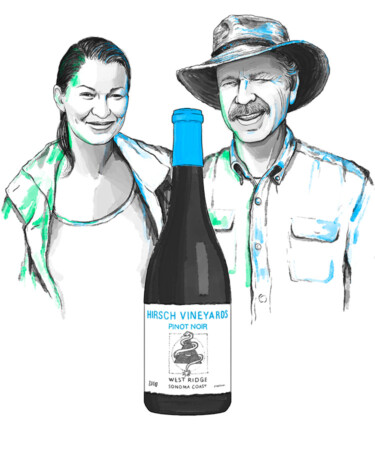David Hirsch never planned that the 1,000-acre isolated sheep ranch overlooking the Pacific Ocean he purchased in 1978 would functionally become the proof of concept for the entire Sonoma Coast wine industry. In fact, he’d never intended to grow grapes in the first place. Instead, the native New Yorker’s only real goal was to acquire a plot of land in California before he was priced out of the market.
Several years later he realized that he needed a source of income from the clear-cut, overgrazed land so that he could attempt to restore it ecologically, and on the advice of an old friend planted Pinot Noir — fitting given Hirsch’s love of red Burgundy. With limited know-how and initial cuttings that turned out to be from Oregon, by 1994 Hirsch had created a vineyard that pioneering winemakers like Burt Williams of Williams Selyem, Ted Lemon of Littorai Winery, and Steve Kistler of Kistler Vineyards came to covet and display prominently on their labels.
In 2002, Hirsch decided to build a winery and make his own wine. With the help of his daughter Jasmine, who joined the winery full-time in 2008 and now serves as the winemaker and head farmer, they began a conversion to biodynamic farming over a decade ago. “Only 72 of the 1,000 acres here are vineyards,” says Jasmine. “Almost all of the rest of the land is left wild, with a few other farming activities to help us with biodynamics. The wild land is so important to trying to restore the land to some of its former ecological diversity and health; my dad doesn’t even know what regenerative agriculture is, but we’re practicing it.”
Much of the modern-day success and acclaim for Hirsch Vineyards comes from Jasmine’s tireless efforts advocating not just for her own wines but for California wine in general. As the co-founder of the influential winemaker organization In Pursuit of Balance, which started in 2011 and ended in 2016, she brought attention to the more restrained style of California Pinot Noir that Hirsch produces, especially since she joined the team. “Why does ripeness and balance matter in Pinot Noir?” asks Jasmine. “It matters because if you can find a vineyard’s appropriate ripeness profile, that’s terroir right there.”
And that’s precisely what you’ll find in a bottle of Hirsch — a mix of wonderfully fresh and tart red fruits that give way to a surprisingly firm and substantial wine, the kind of strength you get from having stared down the power and ferocity of the ocean, and the kind of complexity and elegance that earns you the top spot on our list of the Best Wines of 2021.
The two generations of Hirschs farming and making wine at the edge of the Pacific have undoubtedly inspired many others to plant vines in the area, or to make wines from that fruit, and yet they remain among the very best practitioners in the region, coaxing just enough fruit character and ripeness from this harsh growing area to balance the ample tannins and bracing acidity that come from such cool-climate farming.
Well over three decades into farming the land and two decades into making their own wine, Hirsch remains vital, vibrant, and always alluring.
This story is a part of VP Pro, our free platform and newsletter for drinks industry professionals, covering wine, beer, liquor, and beyond. Sign up for VP Pro now!
